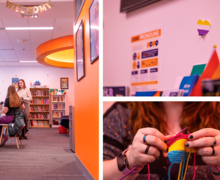Syracuse University among multiple colleges nationwide to experience mumps outbreak
Riley Bunch | Staff Photographer
Syracuse University health officials have said the campus mumps outbreak, at present, is not spreading as fast as it was earlier this semester.
Syracuse University, which has had 45 confirmed and 81 probable cases of the mumps since the end of August, is not the only college that’s grappled with an outbreak of the disease in recent years.
A mumps outbreak at the University of Missouri infected nearly 400 students in a 10-month span after the university confirmed a student contracted the disease in August 2016.
By the time a mumps outbreak at the University of Illinois ended in June 2016, 317 students had been infected.

And 301 students caught the mumps during an outbreak at the University of Iowa between July 2015 and May 2016.
SU health services officials say the disease is not spreading on campus as quickly as before. But, as the number of mumps infections spike nationwide, SU is one of the latest in a growing number of universities forced to handle the highly contagious disease on campus.
According to the Centers for Disease Control and Prevention, 4,980 people contracted the mumps nationwide between Jan. 1 and Nov. 4 this year. In 2016, more than 6,000 cases of the disease were reported, up from about 1,500 cases in 2015. There were less than 500 cases of mumps nationwide in 2012.
Mumps cases reported to the CDC in 2016 and 2017 have primarily been “associated with college settings,” according to the agency.
Brittany Kmush, an assistant professor in the David B. Falk College of Sport and Human Dynamics who studies infectious diseases, said mumps can spread quickly on a college campus because students are interacting in close quarters, such as living together in dorms and coming in contact with each other in classrooms.
But scientists are not sure why the disease has been contracted in such high numbers in recent years.

Andy Mendes | Digital Design Editor
“Our evidence is limited to fully explain what has happened in the last couple of years,” said Kelly Moore, director of the Tennessee Immunization Program at the Tennessee Department of Health. “If the answer were easy, we would have it by now.”
Moore said researchers believe the mumps vaccine’s effectiveness may wane as people get older. That may be one of the reasons why the disease has made a comeback in recent years, she added.
To attend college in New York state, students are required to receive two doses of the measles, mumps and rubella vaccine. Most are vaccinated when they are children.
Since the end of October, SU has hosted seven clinics so students could receive a third dose of the MMR vaccine. Every SU student who has contracted the mumps has been properly vaccinated, though, according to the health services website.
Although a CDC advisory board in October unanimously recommended that people exposed to a mumps outbreak should receive a third vaccine, federal officials also said there was limited scientific evidence showing whether the third dose protected individuals against mumps-related complications, The Washington Post reported.
But is a third vaccine effective?
“The simple answer is yes,” said Patricia Quinlisk, medical director of the Iowa Department of Public Health. But, she added, “It’s obviously more complex than that.”
Quinlisk said the effectiveness of the third MMR vaccine depends on the timing of mumps cases, who the cases are occurring in and whether cases are linked.
A third vaccine is effective, Quinlisk said, if there are multiple mumps cases in a single dorm during a short period of time. If there are isolated cases over a longer period of time, a third vaccine isn’t necessary, she added.
The Onondaga County Health Department only recommended a third dose of the MMR vaccine after it was determined that:
- There was high vaccination coverage at SU
- Exposure settings, such as schools, colleges and dorms, were likely to cause easy transmission of the disease
- There was a high attack rate and transmission of the mumps for at least two weeks
Brad Hutton, deputy commissioner of public health at the New York State Department of Health, said at a press conference in October that the third vaccine will not stop the mumps from infecting those who have already been exposed to the disease.
Still, roughly 30 percent of SU students received a third MMR vaccine through the university’s clinics, said Karen Nardella, medical director of Health Services.
SU’s response to the mumps outbreak
Ben Domingo, director of SU Health Services, said the university has handled the mumps before.
“We actually had a few close calls,” Domingo said. “Last fall we had a case, and then we had a few cases in January.”
None of the previous cases were considered an outbreak, he said. But, he added, those cases helped the university plan how it would confront a larger mumps outbreak.
Nardella said SU officials also looked at how the State University of New York New Paltz and University of Missouri handled mumps outbreaks.
SU’s response to the outbreak has included isolating students with confirmed or probable mumps cases from the rest of the campus community for up to five days.
“The minute we were getting cases we were already familiar with the fact that, this fall, isolation was necessary,” Domingo said.
Students have been housed in South Campus apartments and the Sheraton Syracuse University Hotel & Conference Center. If a potentially infected student lives in university housing with their own bedroom and bathroom, such as on South Campus, they can spend their isolation there, Nardella said. But because some may have roommates, they are asked to wear a mask in the rooms’ common areas.
The minute we were getting cases we were already familiar with the fact that, this fall, isolation was necessary.Ben Domingo
Students can also spend their isolation at home, if they can drive themselves, or their family can pick them up, Nardella added.
The university will check on students periodically while they are in isolation, she said. Students are also delivered food.
After five days in isolation, the student will be allowed to return to campus.
The Onondaga County Health Department in late September ordered SU to “exclude” students from campus who had not submitted vaccination records. Currently, four students remain excluded from campus, Nardella said.
Students can waive New York state’s MMR vaccination requirement for medical or religious reasons.
If a person has a suppressed immune system or is taking certain medications, that could qualify as a medical exemption, Nardella said.
The four students excluded from campus will not be allowed to return to SU until at least Dec. 14. According to Health Services, they must remain off campus for a minimum of 26 days after the most recent confirmed mumps case. If a new mumps case is confirmed, the 26-day exclusion period starts over.
Dolan Evanovich, senior vice president for enrollment and the student experience, said faculty members have made accommodations with those four students so that they can finish the semester.
Students have been able to complete coursework online, Evanovich said, and faculty have been following up with students individually.
There have not been discussions about refunding tuition for the students who, by Dec. 14, will have been excluded from campus for more than two months, he said.
Nardella said the spread of mumps at SU began to slow in mid-November, which she attributes to the vaccine clinics and communications from the university about how to prevent the transmission of the disease.
In mid-November, only two students were in isolation, she said.
Published on November 26, 2017 at 11:39 pm
Contact Jordan: jmulle01@syr.edu | @jordanmuller18





